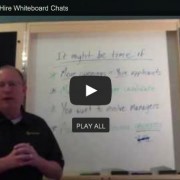Are You Ready for an I-9 Audit?
U.S. immigration policy has always been a hot issue on the campaign trail and in the halls of Congress. However, in recent months, it has risen to become the issue as lawmakers seek to reach a bipartisan agreement on comprehensive immigration reform.
In the background, a dramatic shift is already taking place in regard to the enforcement of federal immigration laws currently on the books. One area that should be of particular importance to employers is the planned increase in I-9 audits by the U.S. Immigration and Customs Enforcement (ICE) agency.
In an October 2017 speech to the Heritage Foundation, the Acting Director of ICE, Thomas Homan, stated that ICE has already “increased the number of inspections and worksite operations,” and that employers would “see that significantly increase this next fiscal year.” According to Mr. Homan, the plan is to increase the time spent on worksite enforcement in 2018 “by four to five times” current levels.
So with an increase in enforcement, need employers worry? That depends on their compliance with the Federal Form I-9 requirements established by the Immigration Reform and Control Act (IRCA).
Number of I-9 Inspections Per Year
What Are the Federal Form I-9 Requirements?
The Form I-9 is used to verify employment authorization and identity of individuals hired for employment in the United States. All U.S. employers must ensure proper completion of Form I-9 for each individual they hire, both citizens and non-citizens alike. Employees and employers (or authorized representatives of the employer) must complete the form within three business days of an employee’s first day of employment. A summary of the general requirements follows:
For Employees (Section 1 Form I-9)
- Attest to their employment authorization
- Present acceptable documents evidencing identity and employment authorization
- Complete the above on first day of paid work
For Employers (Section 2 and 3 Form I-9)
- Examine employee documents to ensure that they are genuine and relate to the employee
- Record information from submitted documents on the Form I-9
- Retain Form I-9 and make it available for inspection by authorized government officers
- Complete above within three days of employee beginning paid work
For a more detailed overview of Form I-9 requirements, visit the USCIS website.
What Are the Penalties for Non-Compliance?
Violation of Form I-9 requirements can happen for a number of reasons, so ICE focuses on the employers intent when determining penalties. This means that violations will fall into two groups: intentional violation and unintentional violation. Within these groups the penalty per violation will vary based on percentage of employees that are in violation and whether the employer is a repeat violator. Additional enhancements (increases) or mitigations (decreases) to the fine may be applied as well.
Penalties for Substantive and Uncorrected Technical Violations (unintentional)
Employers who fail to obtain the appropriate documentation from new employees can be fined between $220 and $1,862 for each violation. These fines are levied for “substantive and uncorrected technical” violations when an employer unknowingly makes an error or experiences a technical error in completing the Form I-9.
Penalties for Knowingly Hire / Continuing to Employ Violations (intentional)
If an employer hired or continues to employ unauthorized individuals, they will be fined between $548 to $21,916 per violation. These fines are for “Knowingly Hire/Continuing to Employ” violations when the employer has an intent to hire or maintain an illegal workforce.
Penalty Enhancement and Mitigation
Within each of the two intent groups above, ICE considers five factors that can increase or decrease the fine. These are the size of the business, good faith effort to comply, seriousness of violation, whether the violation involved unauthorized workers, and history of previous violations. Combined, these factors can increase the standard fines by up to 50% per violation.
Total Fines Levied Per Year
How Can Employers Avoid I-9 Violations?
For employers who don’t want ICE knocking at their doors, the first and obvious step is to not intentionally hire unauthorized workers. The second, more difficult step is to have an air-tight, compliant process in place for completing the I-9 requirements. So what does that look like?
- Remove all I-9 records from personnel files and organize them in a separate I-9 binder–or store them digitally. This makes it easy to access the I-9 files all at once in the event that ICE conducts an inspection.
- Assign a member of you HR team to serve as the I-9 process owner. It will be their responsibility to oversee the I-9 process. Ensure that this person receives annual training on the I-9 requirements.
- Create an onboarding timeline that mandates the completion of I-9 requirements before other activities can be advanced. Remember: new hires must complete Section 1 on their first day of work, and employers must complete Section 2 no later than the employee’s third day of employment.
- Ensure that I-9 documents are verified in person, making it easier to approve the documents as legitimate and reasonably relating to the employee being verified. Never accept faxed or scanned documents for I-9 purposes.
- Allow new hires to choose the I-9 documents that they will present from the list of acceptable documents. This helps employers avoid any issues with document abuse.
- Accept only the minimum number of supporting documents required–do not accept more than needed–but allow the new hire to choose which ones to submit. This, too, helps employers avoid any issues with document abuse.
- For employees who state that their work authorization will expire, record the expiration date in your calendar and set a reminder. Employee onboarding software or an online I-9 system can be valuable in automating these reminders.
- Review your process annually. Employers should ask the human resources team to present and explain their I-9 process. This presentation can be combined with annual training on common I-9 issues or the conduction of an internal I-9 audit.
It’s important to know that the majority of I-9 violations are substantive and the result of human or technical error. This means that having a solid process in place, annual training, and an internal audit will protect most employers from unknowingly committing any violations. When considering the fines that could result from just one I-9 violation, employee onboarding software that automates the I-9 process can prove to be a very smart investment.
To learn more about ExactHire’s employee onboarding software and the ways in which it can protect your organization from compliance risks, contact us today.
Disclaimer:The information provided is not intended to be legal advice.Please seek legal assistance, or assistance from State, Federal, or International governmental resources, to make certain your legal interpretation and decisions are correct for your location. This information is for guidance, ideas, and assistance.
Image Credit: Audit by Nick Youngson CC BY-SA 3.0 Alpha Stock Images








